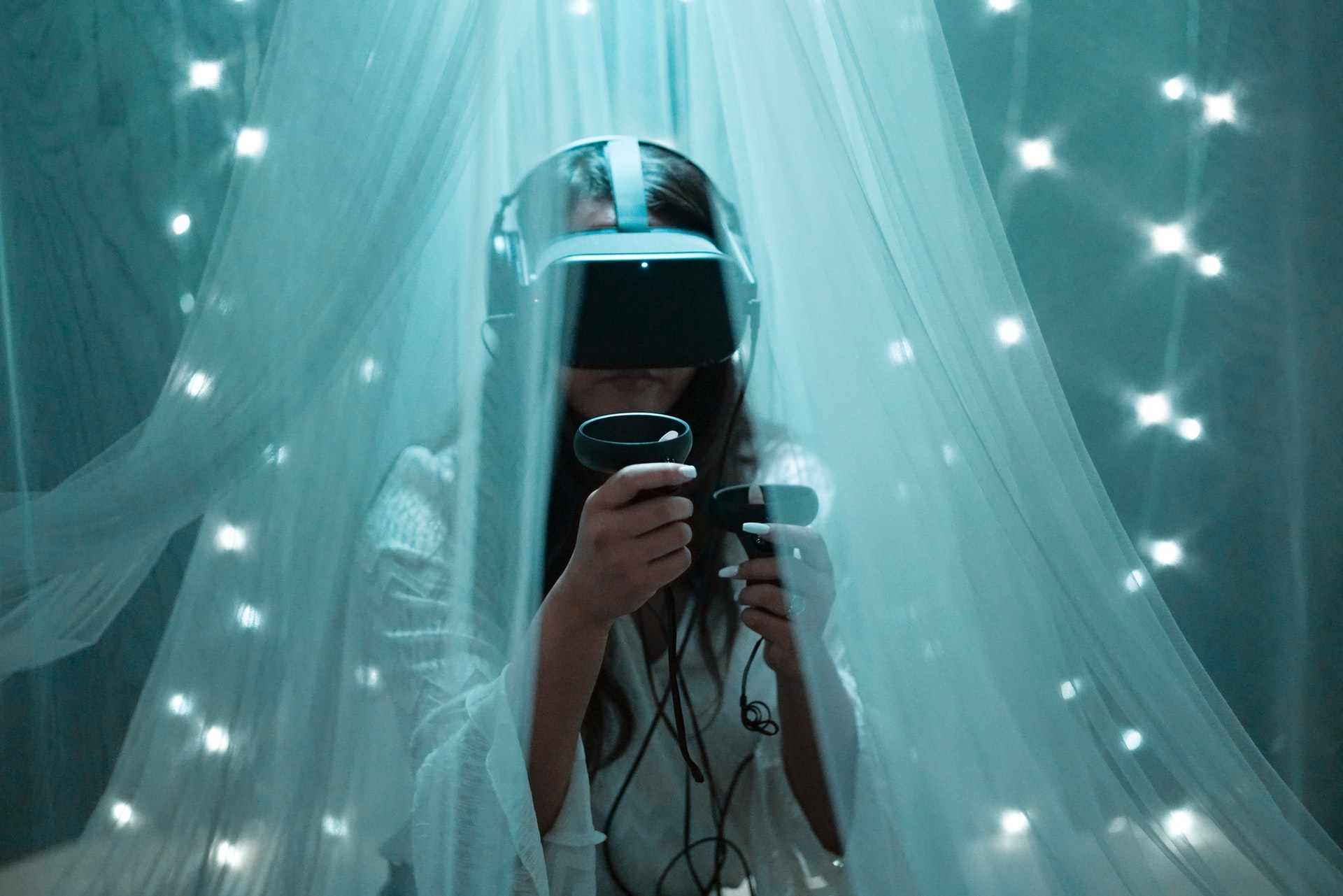
Indira Thouvenin, along with Romain Lelong, delivers a practical book on virtual reality.
Crédits photos : Barbara Zandoval (Unsplash)
In her last book published in the fall of 2020, Indira Thouvenin want to deconstruct the myth of virtual reality. More of a mystery than a myth, immersive technologies raise questions, specifically in the way it is used. Do we really know virtual reality? How to use it? How to develop an immersive experience? Indira Thouvenin, along with Romain Lelong, tries to answer these questions in this book, Virtual reality demystified (“La réalité virtuelle démystifiée”).
Is there a virtual reality myth?
Virtual reality demystified ; this is the title of the new book written by Indira Thouvenin and Romain Lelong. Indira Thouvenin is a virtual reality expert ; a discipline she has been teaching for over 20 years at the University of Technology of Compiègne. In parallel, she conducts scientific research on informed interaction in virtual environment, and is interested in artificial intelligence and the human-machine relationship. Romain Lelong is a virtual reality professional. He cofounded Reviatech, which offers immersive training for industry.
Together, they wrote a book that looks at first glance like a bible on virtual reality. The last book telling the story of the technology was the one by Grigore Burdea and Philippe Coiffet in 1993. Even if this book inspired many people, its publication date is now long ago. Especially for a technology such as virtual reality, which has been undergoing major changes since the 2000s, and continues to evolve every day.
But then, is there a myth around virtual reality? “As professionals, we are immersed in virtual reality every day, and we think people know it well. Mais en réalité, c’est une technologie extrêmement large”, nous explique Indira Thouvenin. Il y a notamment la grande majorité du grand public, pour qui la réalité virtuelle est une technologie peu familière, voire complètement inconnue.
A book for all audiences
“The word ‘demystified’ in the book title refers to my desire to address the general public first”, says Indira Thouvenin. “It’s not easy to write for the general public, especially when you’re a researcher like me, who studies technology in depth.” Nevertheless, the two authors have succeded in this difficult exercise with brilliance! When reading the book, each paragraph can be understandable both by a novice who knows nothing about virtual reality, and by a curious professional who knows the vocabulary and practices.
Like any other manual, Indira Thouvenin and Romain Lelong’s book begins with a brief chapter on history. The two authors review the evolution of virtual reality since the 1960s. They also review all the devices that have been released over the decades and that have been used for immersive experiences for a long time: immersive rooms, Microsoft’s Kinect, the Leap Motion, and of course virtual reality headsets. In the end, only 20 pages are needed to tell the story of the technology; the other part of the book is more like a practical guide.

Virtual reality demystified, a book by Indira Thouvenin and Romain Lelong
The guide to creating a virtual reality experience
Very quickly, from the second chapter, it becomes clear that this book is not intended to be theoretical. “We wanted to write an application guide, and not just provide theory, so that the public and professionals would seize the technology,” says Indira Thouvenin.
Chapter 2 shows the elaboration of a virtual environment, explaining all the elements that compose it: 3D object, texture, material, light, interaction. The next chapter lists all the equipment and interfaces that allow us to visualize these virtual environments. The authors talk about 3D sound rendering, haptic technology, tracking; with a focus on the price of each device, for a more concrete vision.
Chapter 4 deals with the notion of perception: how to make the user feel immersed in a virtual world? The authors also talk about the feeling of embodiement in a virtual body. All these elements introduce chapter 6, which is meant to be a “Short guide to create a virtual world”.
Uses and future of virtual reality
In order to guide those who would like to create an immersive experience, Indira Thouvenin and Romain Lelong dedicate a chapter to the uses of virtual reality. Video games, training, industry, sports, culture, education… many sectors of activity benefit from applications of the technology today.
What about tomorrow? What are the next steps in virtual reality? “Today, and in the near future, what is emerging is a combination of real and virtual,” summarizes Indira Thouvenin in a few lines. According to her, among the next big developments in the immersive world are: mixed reality, social platforms, augmented human, the use of artificial intelligence. “Virtual reality technology is capable of quickly blowing up, as we saw with virtual worlds during the pandemic. In my opinion, virtual humans and robots could represent the future.“
Predicting the future of immersive technologies: a challenge that Indira Thouvenin tries to take up in the conclusion of her book, but also during the Visionaries Think Tank organized during the Laval Virtual exhibition. In 2021, this 2-day brainstorming session gathered industrialists, academics and visionaries around the question: what will immersive technologies look like in 2030? What will they bring to society by then?

